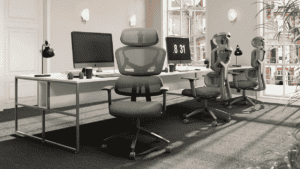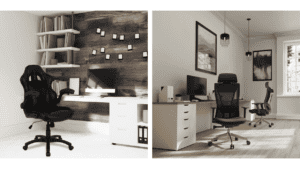Are Gaming Chairs Good for Office Work? Pros, Cons, and Everything You Need to Know
Gaming chairs have surged in popularity, thanks to their bold aesthetics, ergonomic claims, and all-day comfort promises. But are they really a suitable alternative to traditional office chairs, especially if you’re working 8+ hours a day? With the rise of hybrid work, many professionals are asking the same question: Gaming chair or office chair – what’s best for my health and productivity?
In this guide, we’ll explore the advantages and disadvantages of using gaming chairs for office work, compare them to conventional office seating, and help you determine which is the right fit for your workspace.

What Is the Difference Between a Gaming Chair and an Office Chair?
While both types of chairs are designed for prolonged sitting, they differ significantly in design, intent, ergonomics, and how they support your long-term comfort and productivity.
Design Aesthetic
- Gaming chairs are often designed with race car–inspired styling, including bucket seats, flashy colours, contrast stitching, bold branding, and exaggerated headrests. They’re made to stand out and appeal to a younger demographic.
- Office chairs tend to be more minimalist and professional, using neutral colours and sleek lines to blend seamlessly into business environments.
Adjustability & Features
- Gaming chairs frequently come with extreme recline functions (some recline up to 180°), adjustable lumbar and neck pillows, winged shoulder support, and armrests that may or may not offer multidirectional adjustment.
- Office chairs prioritise ergonomics over flash. Features typically include multi-directional armrests, advanced lumbar support (built-in or adjustable), synchro-tilt mechanisms, breathable mesh backs, and seat depth adjustment—designed for long-term postural support
Intended Use
- Gaming chairs are built for gaming sessions that often involve relaxed, reclined postures and extended periods of stillness. They’re not necessarily designed for task-based movement or typing.
- Office chairs are optimised for productivity—keeping users upright and properly aligned during long hours of computer work, meetings, and phone calls.
Build Quality & Materials
- Gaming chairs may use synthetic leather (PU), thick foam padding, and fixed cushions that wear over time. Lower-end models may compromise on build quality to remain affordable.
- Office chairs often feature higher-grade materials like mesh, moulded foam, and more durable frames built for daily use in professional settings.
Space Efficiency
- Gaming chairs are often bulkier, with wide armrests, deep seats, and high backrests. This can overwhelm smaller workspaces or minimalist interiors.
- Office chairs are available in a range of sizes, including compact models ideal for co-working spaces, small home offices, or shared environments.
Aesthetic Fit in Work Environments
- A brightly coloured gaming chair with logos and bucket-style seating may appear unprofessional in formal or client-facing settings.
- A well-designed office chair can elevate a professional workspace while remaining subtle and business-appropriate.
In short, gaming chairs may provide comfort for casual use or short bursts of work, but office chairs are purpose-built for all-day support, workplace functionality, and long-term health.
Pros of Using a Gaming Chair for Office Work
1. Full-Body Support
Gaming chairs often provide extensive padding and contouring, making them comfortable for extended use. Many include detachable lumbar and neck cushions, which can be adjusted to your preference. Some models also feature high-back designs that cradle your upper back and shoulders—something that can be helpful for taller users.
While these supports may not always offer the same customisation or pressure relief as office chairs, they can still offer substantial comfort—especially when compared to low-cost task chairs or dining chairs used in makeshift home offices.
2. High Recline Angles
If you like to take breaks or stretch throughout the day, gaming chairs usually allow a much deeper recline than standard office chairs—some recline as far as 160–180 degrees. This recline range can be useful for short rest breaks or shifting your sitting position throughout the day to reduce pressure on your lower back.
Some high-end models also come with rocking or tilt-lock mechanisms, giving users more freedom to customise their seating angles. This can offer some ergonomic benefit when used occasionally in combination with correct seated posture during focused work periods.
3. Style and Personalisation
From bold colours to stitched logos and adjustable features, gaming chairs offer personal flair and variety. They’re popular with remote workers who want to personalise their home office setup and inject a sense of identity into their workspace.
Additionally, many gaming chairs come in themed or customisable designs—such as those inspired by sports cars, video game franchises, or esports teams. This level of visual expression is something traditional office chairs typically lack, making gaming chairs more attractive for users who prioritise aesthetics.
4. Affordability (in some cases)
Entry-level gaming chairs may be more affordable than mid-tier ergonomic office chairs, offering a budget-friendly option for those upgrading from basic seating. While premium gaming models can be expensive, many budget-tier options include appealing features like neck cushions, full recline, and height-adjustable armrests at a price point lower than many ergonomic chairs.
This makes gaming chairs particularly attractive to students, gamers with occasional work-from-home needs, and budget-conscious users who still want a chair that looks and feels more premium than a standard plastic task chair.

Cons of Using a Gaming Chair for Office Work
1. Questionable Long-Term Ergonomics
While gaming chairs often claim ergonomic design, they’re primarily built for short-term comfort during gaming sessions, not for continuous 8-hour workdays. Features like exaggerated headrests and winged backrests can encourage users to lean back and adopt reclined postures that are less ideal for focused, upright desk work. Over time, this can result in poor spinal alignment, neck strain, and fatigue—especially if the lumbar pillows are not correctly positioned or supportive enough.
Additionally, unlike ergonomic office chairs that promote active sitting and postural shifts, most gaming chairs restrict lateral movement with rigid side bolsters.
2. Bulky and Space-Consuming Design
Gaming chairs often have a large footprint, high backs, and wide bases. In compact offices or shared environments, this can make them impractical. Their bold design may visually clutter a minimalist setup or overwhelm a small home office. The fixed size and structure of many gaming chairs also make them harder to store or slide under desks compared to streamlined office chairs.
If space efficiency is a priority—especially in hot-desking or agile working environments—a gaming chair is usually not the best fit.
3. Limited Adjustability in Budget Models
While high-end gaming chairs do offer advanced features, most affordable models compromise heavily on customisation. For example:
- Armrests may only move up and down (not sideways or diagonally)
- Seat depth may be fixed, causing discomfort for users of varying heights
- Recline mechanisms are often less refined and lack tension control or locking features
In contrast, even mid-range ergonomic office chairs typically offer more nuanced control over tilt tension, lumbar positioning, and seat pan depth, allowing a better personalised fit.
4. Not Office-Appropriate in Formal Settings
The loud designs, vivid colours, and gaming-inspired branding of many chairs can clash with the decor of traditional offices. In client-facing roles, professional settings, or corporate environments, gaming chairs may appear unprofessional or out of place. This could unintentionally undermine your image or workplace credibility.
For companies with a branded or cohesive interior design approach, neutral-toned office chairs will typically be the preferred option to maintain a polished look.
5. Build Quality Can Vary Greatly
Many budget gaming chairs use synthetic leather (PU), plastic frames, and entry-level cushioning that can degrade quickly with daily use. Armrests may loosen, upholstery may peel, and seat cushions may flatten—leading to discomfort and the need for early replacement. This isn’t just a matter of comfort—it can also impact cost-efficiency in the long run.
Ergonomic office chairs, while possibly more expensive upfront, are often made with breathable mesh, reinforced materials, and long-lasting mechanisms that offer greater reliability and longevity.

Gaming Chair vs Office Chair: A Direct Comparison
| Feature | Gaming Chair | Office Chair |
| Ergonomics | Moderate to good | Excellent (with the right model) |
| Recline Functionality | Deep recline (up to 180°) | Moderate recline |
| Aesthetic | Bold, colourful | Neutral, professional |
| Customisation | Pillows, colours, styles | Size and feature-based configurations |
| Work-Focus Design | Secondary | Primary |
| Space Efficiency | Often bulky | Space-conscious models available |
When a Gaming Chair Might Work
A gaming chair could be a reasonable option if:
- You work from home and value aesthetics, visual expression, and deep recline functionality.
- Your budget is limited, and you’re comparing entry-level office seating options.
- You take frequent breaks and don’t sit in the same position for long hours, allowing your body to shift and avoid static posture fatigue.
- You need a temporary solution while transitioning to a long-term office setup.
- You enjoy personalising your workspace with bold colours and branding.
However, if your primary concern is spinal health, posture, and long-term comfort, a purpose-built office chair is almost always the safer investment for daily work use.
Better Alternatives: Office Chairs Designed for Comfort
Rather than compromise, consider an ergonomic office chair that’s designed specifically for desk-based productivity. These chairs prioritise posture, movement support, and seated endurance.
Advanced features—such as adjustable lumbar support, seat depth options, breathable mesh backs, and multi-way armrests—offer a superior ergonomic experience over most gaming chairs. Office chairs are also available in professional styles that fit seamlessly into business interiors, offering form alongside function.
For those who want added back support, explore the benefits of using a lumbar support office chair to reduce fatigue and enhance comfort throughout the day.
If you’re unsure where to begin your search, explore our ultimate guide on how to choose an office desk chair, which outlines everything from seat depth and lumbar support to armrest styles and tilt adjustments.

Who Should Avoid a Gaming Chair for Office Use?
Gaming chairs might not be suitable if:
- You have specific back, neck, or posture concerns
Individuals with musculoskeletal issues or those recovering from injury need precise ergonomic support. Gaming chairs often rely on fixed cushions and exaggerated contours, which may not provide the tailored spinal alignment needed for rehabilitation or long-term comfort.
- You need long-term durability for 8+ hours/day use
Most gaming chairs, especially budget models, aren’t designed for continuous, high-intensity use. The padding can degrade, and the mechanisms may become unreliable over time, making them a poor investment for full-time work.
- You work in a formal or client-facing environment
Gaming chairs often clash with traditional office aesthetics. Bright colours, bold stitching, and oversized branding can detract from a professional image, especially in environments where first impressions matter.
- You want to maintain a minimalist or coordinated office design
If you value visual harmony in your workspace, the bulk and flashy design of gaming chairs may stand out awkwardly. Office chairs come in a variety of sleek, neutral options that complement modern interiors.
- You require fine-tuned adjustability for posture correction
Ergonomic office chairs usually offer more refined customisation, such as seat pan depth, dynamic lumbar adjustments, and synchro tilt features, allowing better posture optimisation than what most gaming chairs can offer.
- You share your workspace or use hot-desking setups
The fixed size and bulky design of gaming chairs make them less adaptable to shared or flexible work environments. Office chairs, by contrast, are often designed to accommodate multiple users with varying ergonomic needs.
In these cases, the ergonomic and professional benefits of a quality office chair outweigh the stylistic appeal of gaming models.
Explore High-Quality Office Furniture Solutions
At BT Office Furniture, we offer a wide range of high-quality office furniture solutions for businesses, remote professionals, and commercial spaces across the UK. From executive seating to ergonomic chairs that meet modern workplace needs, our products are crafted to improve posture, productivity, and longevity.
If you’re still comparing a gaming chair vs office chair, our team is happy to help you weigh your options and choose a seating solution that fits both your style and your daily workflow.
Call 0800 298 7033 or email [email protected] for expert advice.

